Puppy
Care
Preparation
What Does Your Puppy Come With?
When you purchase a Salisbury Park Groodle, you can have peace of mind that your puppy will be coming from a loving family. Our puppies are raised in a rural environment where they have the space to be puppies! Your puppy will be available to join your family at 8 weeks of age and will come:
Vaccinated
Your puppy will receive its first C3 and a C2i vaccination at 7 weeks of age. The next C5 vaccination is required at 11 weeks of age. It is very important that you do not take your puppy into public places until the 11 week booster shot has been administered. Your puppy is at risk of deadly diseases and not fully covered until the booster shot is given. It is under strict advice that you keep your puppy in your backyard and away from other dogs whose vaccination history you don’t know during this period.
Microchipped
Your puppy will come microchipped. We will register your puppy’s microchip details with our council, which will then identify your puppy on the national microchip database. You will receive a formal identification certificate via mail, which you will then need to take to your council to register your puppy on the lifetime register at 6 months of age.
Wormed
Your puppy will come wormed with Drontal at 2, 4, 6, and 8 weeks of age. Worming your puppy is essential to the wellbeing of your dog and can result in a longer life expectancy. A continued worming regime with Drontal once every two weeks until 3 months of age is recommended, and then once every month until 12 months of age. When your dog is 12 months of age, worming is required once every three months.
Vet checked
Your puppy comes fully vet checked. Our wonderful and very experienced vet examines your puppy’s structure, bones, eyes, heart, teeth, ears and skin as part of their thorough check.
Puppy proofing your home
Here are a few helpful tips to help keep your puppy out of harm’s way (best done in advance before you arrive home with your puppy):
- Keep household cleaners and chemicals out of puppy’s reach
- Restrict access to plants that are dangerous
- Store breakable items out of the way
- Hide or cover electrical cords so they can’t be chewed
- Keep kids’ toys off the floor. As well as keeping them clean, some parts may be small enough for the puppy to swallow
- Pools or hot tubs need to be fenced off or have a protective cover over them.
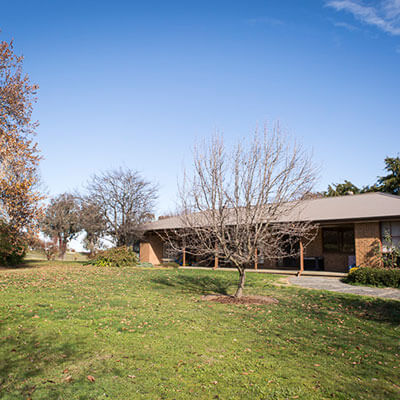
Introduction to the home environment
When your puppy first arrives home, this is a very important time for both parties as it is the commencement of a lifelong relationship. If this is your first experience raising a puppy, prepare yourself for the most wonderful experience… yet it can be frustrating at times. After your journey home, put your puppy out on the grass to relieve itself.
Puppy’s first night
Your puppy is likely to suffer from mild separation anxiety for the first couple of nights away from its littermates. When you get your puppy home, try to engage him/her as much as possible so s/he can get used to the new surroundings. Put them in their sleeping quarters (arrange a small enclosed area) at regular intervals as well. When putting your puppy to bed, put some soft toys and a blanket in the enclosure for comfort, and a hot water bottle in the colder months. Do not leave if your puppy is howling or upset, wait until he or she is calm and relaxed. Be aware that the habits that are created from the beginning will become lifelong habits.
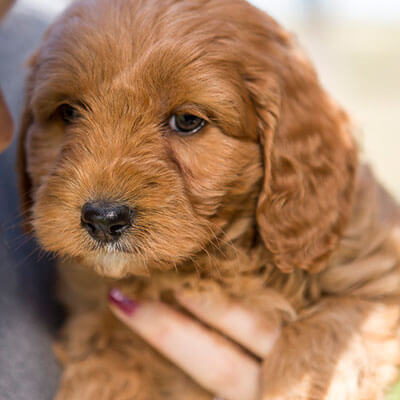

Important Information for Bringing Your New Puppy Home
Transitioning to a new environment can be quite stressful for a puppy. It is important to reduce stress. There a few things you can do to help with this:
- Avoid major dietary changes
- Don’t overtire the puppy
- Let the puppy have undisturbed sleeping and rest periods
- Confine your puppy when it is by itself so it doesn’t get lost or into trouble
- Let your puppy have the company of people as much as possible
- Let your puppy explore your home
- Let your puppy get used to its family before introducing it to new people
- Provide your puppy with fresh water at all times
- Stick to the recommended puppy diet guide
- Put your puppy somewhere quiet so it can eat without distractions.
Puppy Diet Guide
8-12 weeks: 3 meals a day with fresh water to drink
12-20 Weeks: 2 meals a day with fresh water to drink
What to Feed
- Mince: beef or chicken (do not cook)
- Cooked rice or pasta with vegetables occasionally
- Raw eggs and natural yoghurt are good for digestive balance and a shiny coat
- Bones are very good for your puppy while teething
- Raw chicken necks are a good alternative to minced beef from 12 weeks of age.
We advocate staying away from processed, canned, and dry foods as much as possible as they are not recommended for optimum health. If you give your puppy a healthy diet when young, you will reap the benefits during maturity. A natural diet consisting of raw natural foods is best.
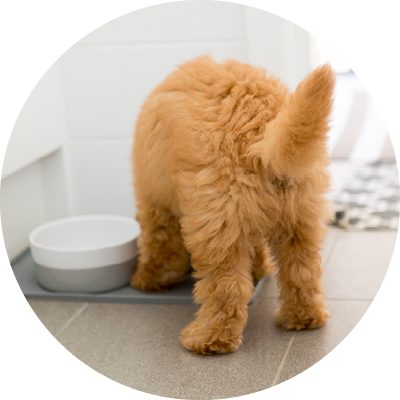
Toilet Training
House training (toilet training) a puppy or a dog takes time and patience and, just as with children, every puppy or dog is different and will learn at their own pace. To make the process of toilet training as successful and as efficient as possible, you need to use reward-based positive reinforcement training. The first step is to give your dog plenty of opportunities to go outside. The second is to reward the dog every time (or as often as possible) they toilet in the place where you want the dog to go.
The reward must occur immediately after the event (within a few seconds), not when the dog comes back inside, as the dog will not make an association between going to the toilet in the right spot and the reward unless it is given straight afterwards. The reward can be in the form of praise (a pat on the chest or saying ‘good’ dog in a pleasant tone of voice), offering a food treat, or giving the dog their favourite chew toy.
This system relies on you supervising the dog as much as possible throughout the day so as not to miss the opportunity to reward the dog for the good behaviour. The more often you can do this, the faster the dog will learn. You should also look out for signs showing the dog is about to go to the toilet so you can take them outside and are ready to reward them as soon as they have finished. When dogs are about to go to the toilet, they tend to sniff the area, circle, and then pause in the spot (though individuals may vary so you should watch your dog to get an idea of what they do).
Remember to take your puppy or dog to the toilet area first thing in the morning, as dogs will often need to go to the toilet at this time. Take them to the toilet area frequently throughout the day following.
It is very important to note that young puppies often do not have full control over their urination until they are a bit older. That is, urination is a developmental process, so very young puppies can make a toileting mistake without being able to prevent or control it.
Puppy Prechool
What is Puppy Preschool?
Puppy classes are designed for puppies aged eight to 16 weeks. During this time, puppies benefit from exploring new places, having new experiences, and accepting new situations. This makes it the perfect time for introducing puppies to lots of people, other dogs, and the big wide world in which it will live.
Although the curriculum may vary from place to place, puppies typically learn to accept being handled, basic obedience, and how to interact and play nicely with other puppies. Owners generally learn about normal puppy behaviour, body language, proper nutrition, and the importance of ongoing socialisation and training.
Why is Puppy Preschool Beneficial?
Benefits for puppies include early socialisation with other puppies and people while the benefits to owners include expert advice and support during the early stages of dog ownership.
There’s no pressure: it is your own personal decision to attend puppy school or not; some people find it beneficial to undertake the training on their own or confining it to the family environment. Either way, training your puppy is a fun experience and, if approached with the right attitude, will lead to great reward.
Basic Training Commands
Good manners are as necessary for dogs as they are for people. A dog who jumps, pulls, barks or lacks self-control often finds himself left out of family activities. An untrained dog may also put your housing situation at risk if you’re a renter. Teach your dog a few basic obedience commands (such as sit, down, come, and stay) using positive training methods, and you will be rewarded with a well- behaved dog who can handle most everyday social situations.
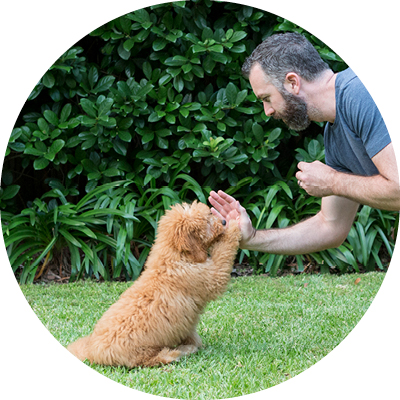
In dog training, timing is everything
Timing is very important. You must mark your dog’s behavior the instant she complies with the command. Saying a single word such as “Yes!” or using a clicker is a good way to mark a correct behavior. It lets your dog know immediately that she’s been successful.
Rewards work better than bribes
Rewarding your dog’s good behavior with a treat is an excellent training tool, but if rewards are overused, they can become bribes. To avoid the treat becoming a bribe, stop luring your dog with the treat as soon as he begins to catch on to what you’re asking him to do. Ask him to “sit,” wait two or three seconds for him to comply, then give him the treat if he sits. Your goal is to teach him to follow a verbal command alone; this will help during those moments when you may not have a treat handy but need him to be on his best behavior.
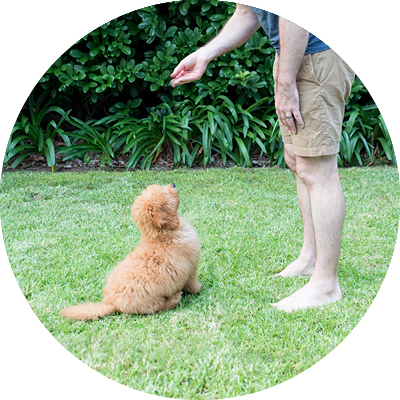
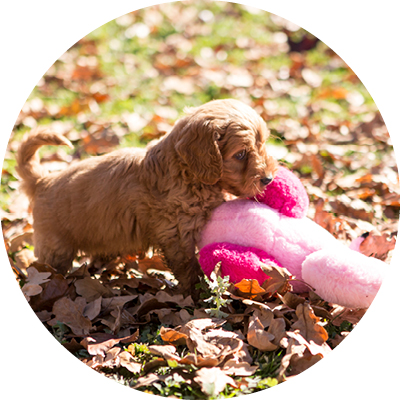
Give your dog life-rewards
Food is the easiest reward to use when you are just learning to train your dog, but it is not the only reward you can use. A toy, a game of fetch, or going for a ride in the car can work, too. For example, let’s say you want to train your dog not to run out the door when you open it. Try this: Tell your dog to sit-stay by the front door of your house. If she complies, praise her, open the door and let her go outside. Going outside is the reward. If she gets up as you open the door, close the door and try again. Repeat the process until she stays in position while you open the door. Only then does she get the reward of going outside.
Use the same technique for opening the car door so your dog can go for a ride. If she remains in position, she is rewarded by getting into the car and going for a ride. (Reminder: never leave your dog unattended in the car).
When dog training, mind your Ps and cues
Your posture and body cues tell your dog a lot. Your dog learns to read your body language much as you learn to read his.
Stand up when you give your dog a command. If you only give commands while sitting or squatting on the floor, your dog will learn to respond only when you’re in that position.
Keep your hands out of your pockets. If his treats are in your pockets, hands in the pockets becomes the cue that he will get a treat if he does what you ask. You want your command to be the cue, not the hand in the pocket. If your hands are always in view, you can keep him guessing.
Similarly, don’t hold a bag of treats in your hand while training. Your dog will learn he only needs to comply with commands if he sees the treat bag, not every time you ask him.
Train your dog everywhere, not just in one room of your house. If you only practice in the kitchen, your dog will learn he only needs to do a command in the kitchen.
As your dog learns to do a command reliably in one location, move to other rooms of the house and the yard. Practice wherever you can, even on your daily walks.

Toxic Food List
Please be mindful that there are certain foods that are toxic to dogs, and can cause severe illness and even death. Some of these foods below:
Chocolate
Onions and garlic
Macadamias and almonds
Grapes and raisins
Pear and apple pips
Plums, apricots and peach seeds
Potato peelings and green potatoes
Rhubarb leaves
Mouldy or spoilt food
Mushrooms
Alcohol
Yeast dough
Coffee grounds, beans and tea
Tomato leaves and stems
Broccoli (large quantities)
Compost
Animal fat (large quantities)
Various common garden plants
Pet Insurance
We highly recommend that you look into pet Insurance before bringing your puppy home. As caring puppy parents, you value your puppy’s health and want to ensure they are always well looked after. Unfortunately, no matter how well you look after them, most dogs will require veterinary treatment at some stage in their life and it can be a very expensive experience. Pet Insurance can help you cover any unexpected vet bills that may arise, and will put your mind at ease knowing you won’t be left in a position where you are unable to give your puppy the treatment he or she requires.
Some of the benefits of having pet insurance include:
- Huge savings if your pet requires major surgery
- Huge savings if your pet needs an extended stay in hospital
- Opens up a range of previously unaffordable treatment options
- Assurance that your pet will get the best possible care
- Savings on preventative treatments (fleas, ticks, heartworm)
- Peace of mind if away on holidays
- The knowledge you are unlikely to ever have to choose between money and the life of your pet.
